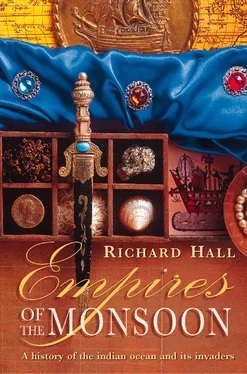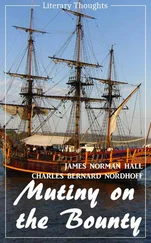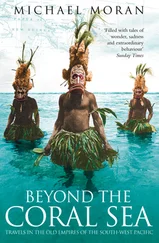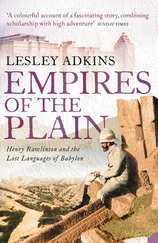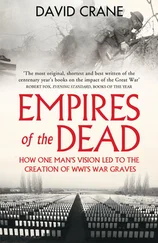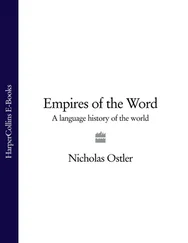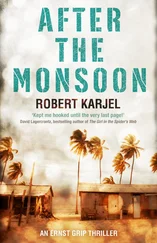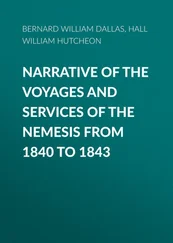Even Siraf could not pretend to compete in luxury or grandeur with Basra – still less with Baghdad, capital of the caliphs. The colossal palaces beside the Tigris, their domes supported on columns of transluscent alabaster, were the wonder of the Arab world. The historian al-Muqaddasi, a contemporary of Buzurg, extolled its splendour: ‘Baghdad, in the heart of Islam, is the city of well-being; in it are the talents of which men speak, and elegance and courtesy. Its winds are balmy and its science penetrating. In it are to be found the best of everything and all that is beautiful … All hearts belong to it, and all wars are against it.’
Although the power of the caliphs, the Commanders of the Faithful, had been fractured by dynastic rivalries, Baghdad still controlled an empire stretching from India to Egypt. Three centuries after its founding, the faith of Islam embraced many more people and far greater territories than Christianity, which was already near the end of its first thousand years. Buzurg’s writings open a window on to this moment, at the ushering in of a new millennium during which the two religions were to be in almost ceaseless conflict.
The cities of Iraq, Persia and India would have astounded the impoverished peoples in the West, had they been aware of them; but Europe’s horizons still scarcely reached beyond the uncertain boundaries of its semi-literate warlords. Western Europe lay on the outer fringes of world civilization, whereas Baghdad could boast of being at its centre, with Constantinople the only rival. The unifying concepts of ‘Europe’ and ‘Christendom’ had yet to take root. Half-pagan, half-Christian raiders from Scandinavia were still able to cause havoc almost everywhere.
Some remnants of classical learning had survived within the walls of European monasteries, but these could not compare with the libraries of Arab scholars, who by now had almost all the great works of ancient Greece available to them in translation. These writings would have been more readily available to Buzurg, a sea-captain in Persia, than to the most learned of Christian bishops in Europe.
Outside the boundaries of Islam, which extended along the coast of North Africa and into Spain, direct contacts between East and West were few. Almost the only European Christians who travelled further than Italy were traders going surreptitiously to Alexandria, pilgrims striving to reach Jerusalem, and young girls and boys sold into slavery. The girls were destined to serve in the Arab harems, in company with female slaves from Ethiopia and the remote African lands south of the Red Sea. The boys were eunuchs, castrated at a notorious assembly point at Verdun in France, taken over the Pyrenees into Spain, and shipped from there to the Indian Ocean countries in the charge of Jewish merchants known as the Radhaniyya (‘those who know the route’).
However, there had been a brief time, at the start of the ninth century, when a positive understanding between Christian Europe and Islam seemed possible. Despite their remoteness from one another, the caliph Harun al-Rashid and Charlemagne, Holy Roman Emperor, several times exchanged ambassadors, bearing messages about a never-fulfilled Arab plan for a concerted war to capture Constantinople, the capital of Byzantium. (The exchange of envoys is mentioned only by Charlemagne’s scribes; Islamic chroniclers probably thought it unworthy of note, since Harun received ambassadors in Baghdad from so many lands and despatched his own in every direction.) In his youth Harun had besieged Constantinople, and now wanted to exploit the divisions between the Catholics and the eastern Christians. He only took this course after vainly despatching envoys to the Byzantine emperor, Constantine VI, urging him to convert to Islam.
The caliph made no such suggestion to Charlemagne, but sent him extravagant presents: jewels, ivory chessmen, embroidered silken gowns, a water clock and a tame white elephant called Abu al-Abbas. Named after the first caliph of the Abbasid dynasty, the animal had once been the property of an Indian rajah. The man who successfully led it home from the Euphrates to the Mediterranean was a Jew named Isaac, sole survivor of a three-man mission to Baghdad. After a hazardous sea crossing to Italy, the elephant was led over the Alps and finally plodded into Charlemagne’s palace in Aix-la-Chapelle on 20 July 802. The emperor soon became devoted to Abu al-Abbas, who withstood the European climate for eight years, until Charlemagne rashly took him to the bleak Luneberg Heath in northern Germany, to intimidate some marauding Danes. 2
These contacts between the caliph of Baghdad and the ‘philosopher-king’ of the Franks had proved to be only a brief flicker of light across the religious and cultural divide. Charlemagne had arranged, with Harun’s approval, for the founding of a Christian hostelry in Jerusalem, and this was the basis of a medieval legend that he had been the first crusader, leading a pilgrim army to the Holy Land. However, the Crusades were launched later – by Pope Urban II in 1095 – and the Arabs were then to be stunned by the uncouth ferocity of their religious foes.
Whereas Christian Europe was confined and cut off from Asia, the non-Christian Europeans – the Arabs settled in Spain and the Mediterranean islands – were free to wander across all the known world, even as far as China. It meant travelling first through Egypt and Arabia to reach some port such as Siraf, from where the ‘China ships’ set out on what was then the longest voyage known to mankind. In one of Buzurg’s stories there is a passing mention of a man originally from Cadiz who had been bold enough to stow away on a ship bound for China. This man had crossed the divide between two contrasting maritime traditions. The twisting, creaking vessel destined for China would have been totally unlike the heavy, broad-bottomed craft, held together with massive nails, which he would have remembered seeing in the harbours of Spain.
The use of coconut-fibre cording to sew the timbers of the Indian Ocean ships was often explained away by the myth of the ‘Magnetic Mountain’; that ships built with nails were doomed if they sailed near the mountain, since every scrap of metal in their hulls flew out towards it. In one of the Sinbad tales, a captain ‘hurls his turban on the deck and tears his beard’ when the Magnetic Mountain looms up in front of his ship, for he knows he is doomed: ‘The nails flew from the ship and shot off towards the mountain. The vessel fell to pieces and we were all flung into the raging sea. Most of us were drowned outright.’ 3
The mundane truth, however, was that Arabia suffered from a shortage of iron, and its swordsmiths always had first call on metal imported from such places as Ceylon and East Africa. On the other hand, it was some consolation that if a ‘sewn’ ship had to be beached for repairs the raw materials were usually to hand, since coconut palms grew almost everywhere beside the Indian Ocean. The ocean also supplied materials for preserving ships’ hulls, which were thickly smeared with oil from the carcasses of sharks and whales (as a ship-building port, Siraf had a factory for treating blubber); the aim was to protect timbers from rotting and keep them flexible, so that ships were less likely to be holed should they strike a coral reef.
These ‘sewn boats’ of the Indian Ocean have a long history. The earliest reference to them is in a nautical guide written by a Greek voyager in about A.D.50. Known as the Periplus [Circuit] of the Erythrean Sea , this survey describes in a practical style the Indian Ocean’s trading conditions and the people to be met with round its shores. It speaks of an East African port named Rhapta (whose site is yet to be discovered) where much ivory and tortoiseshell could be bought and the ‘sewn boats’ were built. 4
Читать дальше
